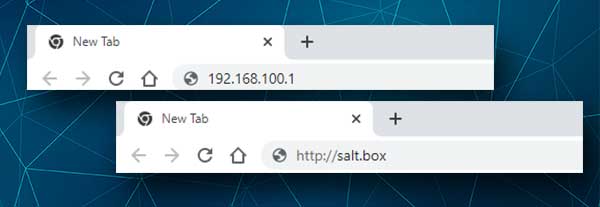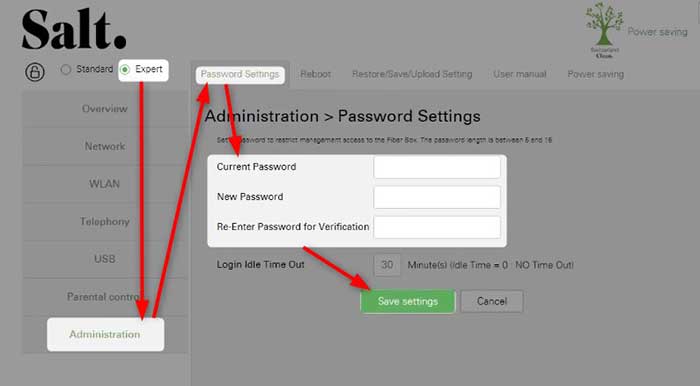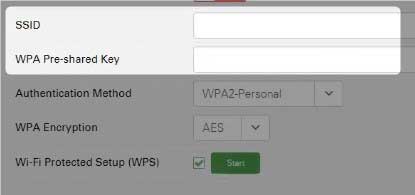Having a fully-functional and secure wireless network is something we are used to today. However, sometimes we want to make some changes to the network settings, like setting up a stronger wireless password, or we have come up with a cool WiFi name and we want to change the current one. This and much more can be changed in the router settings. If you are using a Salt router (Salt Fiber Box) you need to learn the Salt router login steps first.
This article will show you how to access the Salt router settings and how to change the default admin password, and the wireless network name and password.
So, let’s begin!
CONTENTS
What You Need:
- Salt Fiber Box
- Connection to the local network over WiFi or an Ethernet cable
- Computer, tablet or smartphone
- Salt Fiber Box default admin login details
What Are The Default Salt Router Details?
In order to access the Salt router settings, you need to know the default IP address or local web address, and the default admin username and password. If you or someone else, like your ISP, has changed these default details you need to use the custom ones.
Default IP/Local web address: 192.168.100.1 or http://salt.box
Default username: admin
Default password: admin
It is recommended to change these default admin login details the first time you login into your router.
How To Login To Salt Router?
Now, when we have everything ready it’s time to access our Salt router configuration portal.
STEP 1 – Connect The Device To The Network
If you don’t connect your device to the network you won’t be able to login to your Salt router. We have to mention this again, because it is very important. So, connect your device either to the wireless network or use an Ethernet cable and connect the device to the router.
Now, after you have connected the device, we can continue.
STEP 2 – Open The Browser On Your Device
The web browser allows us to access the router’s web-based utility. It is a graphical user interface where all the router settings can be found and configured. You can use any of the browser’s you have already installed on your device.
STEP 3 – Enter The Salt IP Address In The Browser’s URL Bar
Now you have to enter the Salt default IP 192.168.100.1 or the local web address http://salt.box in the browser’s URL bar. Then hit Enter on the keyboard and you should be asked to enter the admin username and password.

STEP 4 – Enter The Salt Admin Username And Password
As mentioned above the default admin username is admin, and the password is admin, too. Enter these login details and click OK and you will be redirected to the Salt admin dashboard.
NOTE: If you have changed these admin login details, type the new username and password. If you haven’t changed them, then make sure to do that as soon as possible. Keeping the default login details is a security risk for your network and they need to be changed. This will prevent anyone accessing your router settings without your authorization.
STEP 5 – Check The Salt Router Options
At this point you will have access to all the Salt router configuration settings. Feel free to explore them and see what you can change. However, before making any changes we recommend creating a backup of the router configuration or simply write down the changes you make. In case something goes wrong you would want to have everything to be like before.
Some of the settings we recommend changing are the admin login password, the wireless network name and password.
How To Change The Salt Admin Password?
Anyone who is connected to your network can access the router settings if he or she knows the default IP, username and password. A quick Google search can help them find these, so it is recommended to change at least the admin password. This is offered during the initial setup, but most people just ignore it. If you want to change the admin password here is where you can find this option in the router settings.
Click on the Expert radio button.
Now click on Administration in the menu on the left.
Select the first tab named Password Settings.
Now you have to enter the old admin password in the Current Password field.
Then enter the new admin password in the New Password and in the Re-Enter Password for Verification fields.

If you want, you can change the Login Idle Time Out. This option allows you to automatically log out of the router settings after the specified time in case you forget to log out from the router admin dashboard.
Click the Save Settings button to confirm your changes.
How To Change The Salt WiFi Name And Password?
Make sure that the Expert radio button is selected.
Now go to WLAN and click on the first tab at the top saying Combined View. Here you can change the SSID and wireless password for both the 2.4 and 5GHz networks.
Change the network name in the SSID field.
Change the wireless password in the WPA Pre-shared Key field.

NOTE: Make sure to set separate SSIDs for the 2.4 and 5GHz network. You can use the same wireless password for both. The wireless password should be 10-12 characters long and it needs to be made of numbers, small and capital letters and special characters.
Now click on Save Settings to confirm the changes. After that you can connect your wireless devices to the new network with the new WiFi password.
Final Words
Now you know how to login to your Salt router and apply some basic security changes to the router settings. Just make sure to have the default and custom login details written somewhere and keep them safe. You will need them the next time you want to make some changes.

Hey, I’m David. I’ve been working as a wireless network engineer and a network administrator for 15 years. During my studies, I also worked as an ISP field technician – that’s when I met Jeremy.
I hold a bachelor’s degree in network engineering and a master’s degree in computer science and engineering. I’m also a Cisco-certified service provider.
In my professional career, I worked for router/modem manufacturers and internet providers. I like to think that I’m good at explaining network-related issues in simple terms. That’s exactly what I’m doing on this website – I’m making simple and easy-to-follow guides on how to install, set up, and troubleshoot your networking hardware. I also review new network equipment – modems, gateways, switches, routers, extenders, mesh systems, cables, etc.
My goal is to help regular users with their everyday network issues, educate them, and make them less scared of their equipment. In my articles, you can find tips on what to look for when buying new networking hardware, and how to adjust your network settings to get the most out of your wi-fi.
Since my work is closely related to computers, servers, and other network equipment, I like to spend most of my spare time outdoors. When I want to blow off some steam, I like to ride my bike. I also love hiking and swimming. When I need to calm down and clear my mind, my go-to activity is fishing.
